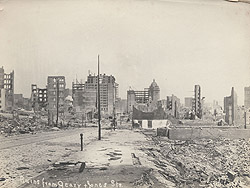Berkeleyan
Because it's everybody's fault . . .
The campus host exhibits, conferences, and films that both celebrate and warn of the power of earthquakes
![]()
| 05 April 2006
As we count down the days to April 18, the 100th anniversary of the 1906 earthquake and fire, the campus is abuzz with programs, displays, and performances drawing inspiration from that earth-shaking event. What follows is a rundown of the highlights.
Exhibits
 The Bancroft Library's extraordinary collection of photos from the 1906 earthquake and fire forms the basis of its new onlive archive, described at left. (Courtesy the Bancroft Library) |
In a collection that provides the raw materials for a host of other venues, the Bancroft Library has assembled a comprehensive online archive on the "1906 San Francisco Earthquake and Fire." Drawing on photographs, text documents, film and audio clips, maps, and other digitized material, the collection amounts to a virtual museum of original historical artifacts created at the time of the tragedy. Highlights include an interactive map showing the quake's effects neighborhood by neighborhood, and a 360-degree panoramic photo montage of the ruined city. The exhibit draws on material from the Bancroft Library, the California Historical Society, the California State Library, Stanford University, the Huntington Library, and the Society of California Pioneers.
The Bernice Layne Brown Gallery in Doe Library is hosting a pair of exhibits on the quake. In "The History of a Disaster" (on display through April 12), manuscripts, photographs, prints, books, and ephemera from the Bancroft's collections provide a historical look, also highlighting the massive relief effort after the disaster and Berkeley's role in that effort. Then, starting April 21, the gallery will shift gears to the present with "The Legacy of the Disaster," a display focusing on contemporary approaches to earthquake preparation and retrofitting and highlighting Berkeley's cutting-edge contributions to engineering and earthquake science. This second collection will be on display through August.
Conferences and lectures
The granddaddy of U.S. earthquakes is being marked by the granddaddy of earthquake forums: the 100th Anniversary Earthquake Conference, jointly hosted by the Earthquake Engineering Research Institute, the Seismological Society of America (SSA), and Disaster Resistant California (California's Office of Emergency Services). Titled "Managing Risk in Earthquake Country," the April 17 to 21 conference at San Francisco's Moscone Center will celebrate what has been accomplished during the past century, showcasing best practices and research results in science, engineering, and emergency management. Berkeley's Seismological Laboratory is co-hosting the SSA's annual meeting as part of the conference, and Berkeley researchers associated with the Earthquake Engineering Research Center and the Pacific Earthquake Engineering Research Center have been deeply involved in planning EERI's part of the conference. For information, visit 1906eqconf.org/index.htm.
The Institute of European Studies is holding a May 22 conference on "The San Francisco Earthquake of 1906: Urban Reconstruction, Insurance, and Implications for the Future." The panel discussion will feature three German experts discussing the disaster, including its little-known impact on European insurance and reinsurance companies. For information, visit ies.berkeley.edu.
Cal Day
The April 22 campus open house will feature several events for the seismologically inclined.
In the Berkeley Seismology Lab, visitors can learn about earthquakes through hands-on demonstrations and activities, plus displays on seismic hazards, earthquake monitoring, and recent and past events. Or come face-to-face with seismic safety on an Earthquake Retrofit Tour, learning how the SAFER Program has been strengthening and replacing campus buildings to resist the next big earthquake. These tours, sponsored by Capital Projects and the Vice Provost - Academic Planning and Facilities, include a pocket-size tour book that will be available through Visitor Services after Cal Day.
Civil and Environmental Engineering will present videos and demonstrations on "Bracing for the Next Earthquake," and professor Michael Riemer will give a talk on liquefaction and why it is so dangerous in a quake.
At the Lawrence Hall of Science, kids will become junior seismologists in "Quakes and Shakes" as they predict earthquake damage, brainstorm retrofit strategies, and take part in exciting, interactive demonstrations of plate tectonics. (Seating is limited, so come early.)
Tapes of all the talks in the now-concluded Earthquake Centennial Lecture Series will also be available for listening. And the Brown Gallery exhibit on earthquake preparation and retrofitting (see above) will be open on Cal Day. Details on all these programs will be available on the Cal Day website (www.berkeley.edu/calday) in early April.
Also on Saturday, April 22, the Berkeley Historical Society is planning a walking tour of three sites reflecting campus earthquake- relief efforts in 1906, which included tent cities for refugees. For information, visit www.ci.berkeley.ca.us/histsoc.
Performances
The Pacific Film Archive has programmed "65 Seconds That Shook the Earth: Commemorating the 1906 San Francisco Earthquake," April 6 to 9. This weekend-long film series features Earthquake, the first seat-shaking Sensurround film; an illustrated lecture by Gray Brechin about the 1906 destruction, with archival newsreels galore; John Wayne wandering the ruined streets of San Francisco in Flame of the Barbary Coast; and the late-'50s disaster flick The Night the World Exploded, with an on-site seismologist to lay bare its unsound science. For more information, visit www.bampfa.berkeley.edu/pfa_programs/65secs/index.html.
Publications
Stephen Tobriner, professor of architectural history, has a new book coming out this month: Bracing for Disaster: Earthquake-Resistant Architecture and Engineering in San Francisco, 1838-1933. The book, which looks at which San Francisco buildings were damaged by quakes and which survived and identifies the city's unsung heroes, is published by Heyday Books in collaboration with Berkeley's Bancroft Library Press.

